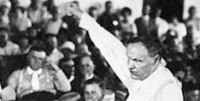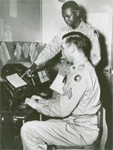There are a number of wonderful sites for someone looking for background information about World War II, and the experiences of military men and women abroad and at home. Unfortunately, while there is considerable general information, the experiences of specific veterans can be widely varied—extending across the globe, and over land, sea, and air. Given the large number of units and the many changes in deployments over the course of the war, it can be difficult to find information about specific units on the web.
As a starting point, to transport your students back into the period you might start with some of the very broad overviews of the war by sites such as the History Channel. And (with proper warnings about the way they exaggerate and oversimplify) you might have them look at one of the War Department’s Why We Fight documentaries.
As they try to get a closer understanding of the specific experiences of particular service people and their units, your students can look at the materials prepared by the military services, which have substantial resources on the web (though they are a pretty clunky). For information on ground forces, they should check out the Army’s U.S. Center for Military History. Much of the material here consists of digitized version of print publication (hence the rather look), but it provides very comprehensive information about particular events.
The Naval History Center offers similar information for the U.S. Navy and Marine corps. Those are probably your best sources for information on the web at the unit level.
The National Archives also offers a treasure trove of information digitized from their collections, which includes everything from enlistment records of particular soldiers to photographs from the period. It can be hit-or-miss the closer you try to get to a specific person or unit, but it does provide some excellent examples of their specific experiences at the time.
Finally, the Library of Congress’s Veteran’s History Project provides a model of the kinds of information students might want to gather from each of the veterans they interview. Each interviewee in the database has a small fact sheet summarizing the key elements of their careers, and also offers digitized recordings of interviews with service men and women.
These are the best sources of information about World War II I have found on the web, though there are dozens of other sources available out there of widely varied quality. Most of the other sites are either extremely dated or are quite general summaries of broad themes and specific battles or events, but these sites should get your students started and on the right track.


